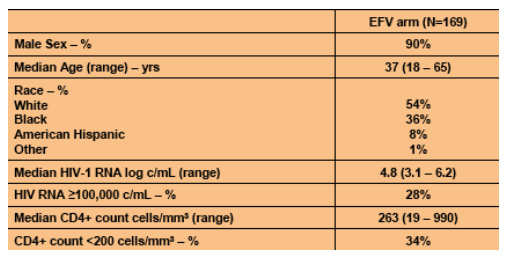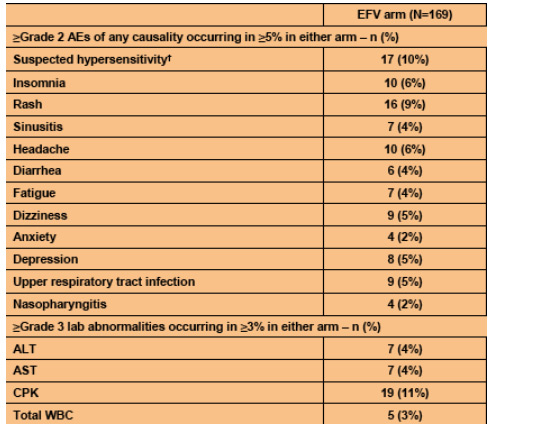 |
 |
 |
| |
Abacavir/3TC+EFV: two pills once daily
|
| |
| |
"Efficacy and Safety of Once-Daily Abacavir/Lamivudine
Fixed-Dose Combination (ABC/3TC) + Efavirenz (EFV):
ESS30009 Planned 48 Week Analysis'
Reported by Jules Levin
IAS-Rio July 2005
Poster Number WePe12.2C23
J. E. Gallant1, A. E. Rodriguez2, W. Weinberg3, B. Young4, D. Berger5, M. L. Lim6, Q. Liao6, L. Ross6, J. Johnson6, M. S. Shaefer6
1Johns Hopkins Univ, Baltimore, MD; 2Univ of Miami, Miami, FL; 3Kaiser Permanente, Atlanta, GA; 4Rose Med Center, Denver, CO; 5Northstar Med Center, Chicago, IL; 6GlaxoSmithKline, Research Triangle Park, NC
Epzicom/Kivexa is a once-daily fixed-dose combination (FDC) containing 600mg abacavir (ABC) and 300mg lamivudine (3TC).
ESS30009 compared the efficacy and safety of two once-daily regimens, each administered as two-pills, once-daily:
Arm A: EFV + ABC/3TC FDC
Arm B: TDF + ABC/3TC FDC
AUTHOR DISCUSSION
In this planned 48 week analysis, 71% of treatment-na´ve subjects receiving a two pill, once-daily regimen of EFV + ABC/3TC FDC achieved viral suppression to <50 c/mL (ITT-e, M=F). This response is consistent with prior studies utilizing separate ABC and 3TC components, either once-daily or twice-daily.
EFV + ABC/3TC was generally safe and well-tolerated. Overall, ABC hypersensitivity reaction occurred in 7% of all subjects exposed to ABC and was clinically manageable.
TDF + ABC/3TC was associated with poor virologic response and high rates of selection for the M184V/I and K65R mutations. An unplanned interim analysis demonstrated early virologic non-response in 49% of the TDF arm and
rapid selection for K65R + M184V/I in the majority. The TDF + ABC/3TC regimen was prematurely terminated and subjects were permitted to switch to an investigator-selected second-line regimen.
Subject Demographics

Virologic Response at Week 48 and Disposition
up to Week 48 - n (%)
Subjects who continued beyond 48 weeks in an extension phase maintained virologic suppression; 22 of 22 (100%) of subjects remaining in study at 84 weeks achieved HIV-1 RNA <50 c/mL (observed).

*Baseline resistance (n=3), non-adherence (n=3), incarceration (n=3), non-protocol defined failure (n=1).
Three subjects were protocol-defined virologic failures in the EFV arm. Of these, virus from one subject had K103N at baseline, while HIV-RNA was below technical limits of assay (>400 but < 600 copies/mL) at time of failure (week 24). Virus from the second subject was wildtype at baseline and at time of virologic
failure. K103N and L100I were selected in virus from the third subject by the time of virologic failure, followed by additional selection for Y115F.
Median CD4 cell count change from baseline (IQR) in EFV arm: Week 8 111 cells/mm3 (44 - 201), Week 16 126 cells/mm3 (56 - 193), Week 24 132 cells/mm3 (51 - 213), Week 32 111 cells/mm3 (51 - 197), Week 40 133 cells/mm3 (59 - 203), Week 48 130 cells/mm3 (65 - 217).
Summary of Adverse Events and Laboratory
Abnormalities

The majority of suspected hypersensitivity reactions to abacavir did not result in study withdrawal; 11 subjects in the efavirenz arm and 5 in the tenofovir-DF arm discontinued abacavir/lamivudine and switched to lamivudine/zidovudine. Suspected hypersensitivity reactions were subjectively rated as Grade 2 (61% of cases) or Grade 3 (39% of cases) and resolved after discontinuation without
sequelae.
An unplanned interim analysis demonstrated early virologic non-response in 49% of the TDF arm and rapid selection for K65R + M184V/I in the majority. The TDF + ABC/3TC regimen was prematurely terminated and subjects were permitted to switch to an investigator-selected second-line regimen. No concerns were raised in the EFV arm and this arm continued unchanged.
|
| |
|
 |
 |
|
|